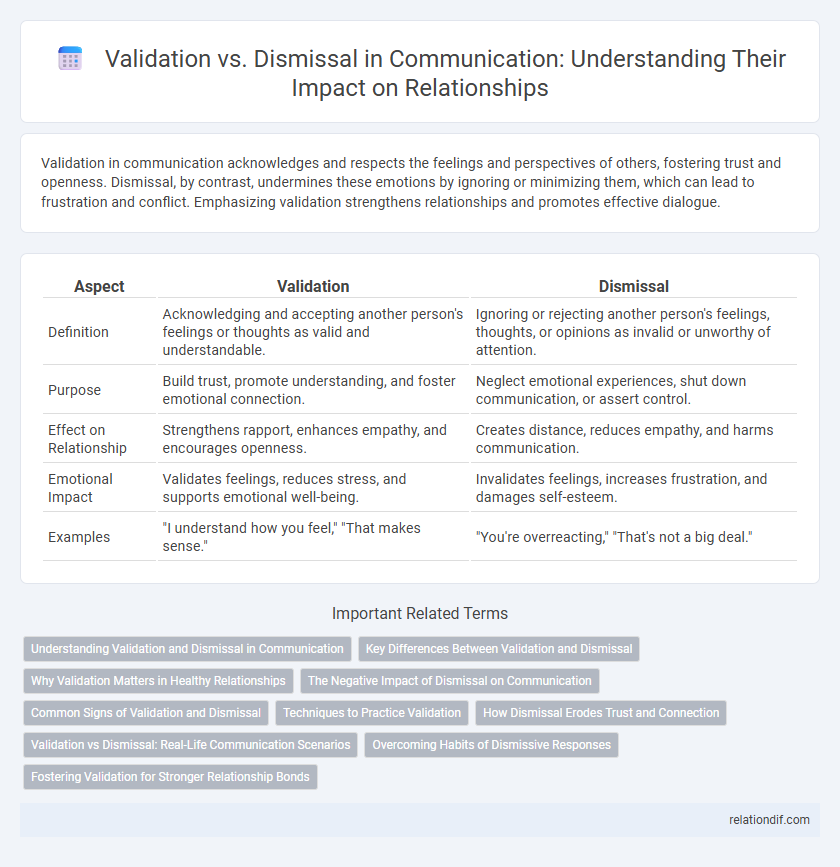Validation in communication acknowledges and respects the feelings and perspectives of others, fostering trust and openness. Dismissal, by contrast, undermines these emotions by ignoring or minimizing them, which can lead to frustration and conflict. Emphasizing validation strengthens relationships and promotes effective dialogue.
Table of Comparison
| Aspect | Validation | Dismissal |
|---|---|---|
| Definition | Acknowledging and accepting another person's feelings or thoughts as valid and understandable. | Ignoring or rejecting another person's feelings, thoughts, or opinions as invalid or unworthy of attention. |
| Purpose | Build trust, promote understanding, and foster emotional connection. | Neglect emotional experiences, shut down communication, or assert control. |
| Effect on Relationship | Strengthens rapport, enhances empathy, and encourages openness. | Creates distance, reduces empathy, and harms communication. |
| Emotional Impact | Validates feelings, reduces stress, and supports emotional well-being. | Invalidates feelings, increases frustration, and damages self-esteem. |
| Examples | "I understand how you feel," "That makes sense." | "You're overreacting," "That's not a big deal." |
Understanding Validation and Dismissal in Communication
Understanding validation in communication involves recognizing and affirming another person's feelings, thoughts, or experiences, which fosters trust and emotional connection. In contrast, dismissal occurs when someone's perspective is ignored, minimized, or invalidated, often leading to misunderstandings and emotional distancing. Effective communication hinges on balancing validation to promote empathy while avoiding dismissal that can hinder meaningful dialogue.
Key Differences Between Validation and Dismissal
Validation involves recognizing and accepting another person's feelings or thoughts as legitimate, fostering trust and emotional connection. Dismissal, by contrast, rejects or minimizes these emotions, often leading to feelings of invalidation and misunderstanding. Key differences include the impact on relationship dynamics, where validation promotes empathy and open communication, while dismissal can create distance and emotional harm.
Why Validation Matters in Healthy Relationships
Validation plays a critical role in healthy relationships by fostering emotional safety and mutual respect, which enhances trust and openness between partners. Recognizing and affirming each other's feelings supports effective communication and reduces conflicts, promoting long-term connection and understanding. Emotional validation strengthens relationship resilience by enabling partners to navigate challenges collaboratively and maintain positive interaction patterns.
The Negative Impact of Dismissal on Communication
Dismissal in communication undermines trust and emotional safety, leading to increased misunderstandings and conflict. It invalidates feelings and experiences, causing frustration and disengagement that impede effective dialogue. Persistent dismissal fosters resentment and erodes relationship quality, making collaboration and resolution difficult.
Common Signs of Validation and Dismissal
Common signs of validation include active listening, empathetic responses, and acknowledging emotions, which foster trust and open communication. In contrast, dismissal is characterized by interrupting, belittling feelings, and ignoring concerns, leading to emotional shutdown and conflict. Recognizing these behaviors enables healthier interpersonal interactions and emotional support.
Techniques to Practice Validation
Techniques to practice validation in communication include active listening, reflecting emotions, and acknowledging the speaker's perspective without judgment. Using empathetic statements such as "I understand how you feel" or "That sounds really challenging" reinforces emotional validation and strengthens trust. Nonverbal cues like nodding and maintaining eye contact also enhance the effectiveness of validation by demonstrating genuine attention and respect.
How Dismissal Erodes Trust and Connection
Dismissal in communication undermines trust by invalidating the speaker's feelings and experiences, causing emotional distancing and reluctance to share openly in the future. When individuals feel dismissed, their sense of being heard and respected diminishes, weakening interpersonal bonds and reducing the effectiveness of communication. This breakdown in connection hinders collaboration and emotional intimacy, essential components for healthy relationships and constructive dialogue.
Validation vs Dismissal: Real-Life Communication Scenarios
Validation in communication involves acknowledging and accepting another person's feelings or perspectives, fostering trust and empathy in conversations. Dismissal occurs when someone's thoughts or emotions are ignored or minimized, often leading to misunderstandings and emotional disconnect. Real-life scenarios reveal that validation enhances relationship building, while dismissal can escalate conflicts and hinder effective communication.
Overcoming Habits of Dismissive Responses
Overcoming habits of dismissive responses requires conscious practice in active listening and empathy to validate the speaker's feelings and perspectives accurately. Validating communication fosters trust, emotional safety, and openness, contrasting sharply with dismissal that often leads to misunderstanding and emotional detachment. Consistent validation techniques include acknowledging emotions, paraphrasing statements, and avoiding interruptive or minimizing language to build stronger interpersonal connections.
Fostering Validation for Stronger Relationship Bonds
Acknowledging and affirming another person's feelings establishes trust and deepens emotional connections in communication. Validation validates individuals' experiences, promoting mutual respect and openness while reducing defensiveness and conflict. Prioritizing validation over dismissal strengthens relationship bonds by creating a safe space for genuine expression and understanding.
Validation vs Dismissal Infographic

 relationdif.com
relationdif.com